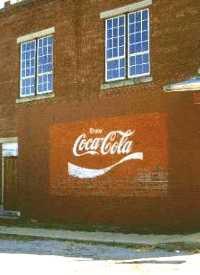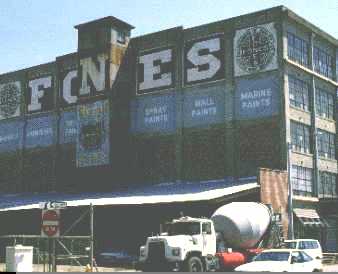GHOSTS ON THE BRICKS
by Joel M. VanceIt's a ghost story without a single chill. You've seen these ghosts -- everyone has -- but they probably didn't even register. "Ghost" signs, the advertisements on the walls of commercial buildings that once were as common as...well, television commercials.

Coke signs may be the last survivors of our advertising world.
PHOTO CREDIT: JOEL VANCE
Remember an invitation to drink Grapette? The first injunctions to quaff the soda pop that left your tongue blue appeared on walls around Camden, Arkansas, where the drink originated in 1930. There still are a few faded reminders today ... ghosts almost as fleeting as the lingering flavor on your blue tongue.
Give a sign painter a red brick wall and he'd give you an advertisement for clothing, feed or seed, flour, cigars, tonics, beer, tobacco, hardware, petroleum products, cigars, even undertaking and embalming.
Some of the advertisements were on the roofs or walls of huge wooden barns, themselves an anachronism today. As old barns collapse or are torn down, so go the signs proclaiming the virtues of Day's Work tobacco or various tourist attractions.
And there aren't many ads on the sides of Butler Buildings. Today, billboards and neon signs largely have replaced the wall signs of yesteryear.
The old sign painters used white lead for white, lampblack for black. They'd make a paper pattern of the design, then perforate the lines with a small device called a pattern wheel, a tiny spiked wheel on a handle. Roll the wheel around the lines of a pattern and the spikes would leave a series of holes.
Then the painter would fasten the pattern to the wall and pat the outline with a cotton bag filled with chalk or powdered charcoal, called a "pounce" bag. The result was a dotted line, like connect-the-dots drawing.
The paint was mixed with linseed oil and vanish, with perhaps gasoline as a rapid drying agent. The result was long-lasting, though time and sun ages all paint. 
Brick buildings and ghost paintings.
PHOTO CREDIT: JOEL VANCE
White lead deteriorated slowest of all the pigments, so many signs today are white "ghosts" of the original.
Many old signs have vanished beneath fresh paint or stucco. Once painted over, the signs are destroyed, but stucco can fall off and, like a Rembrandt beneath a painting of poker playing dogs, the classic artwork resurfaces.
We pass these fading examples of folk art without a second glance--old brick walls and barn sides proclaiming the virtues of products long since vanished from the market. All that remains is a wispy spirit, clinging to crumbling walls.
GHOSTBUSTERS
The Arkansas Historic Preservation program has recognized the value of "ghost signs" and actively searches for the survivors. You can report Arkansas sightings to them at 1500 Tower Bldg., 323 Center St., Little Rock 72201.
